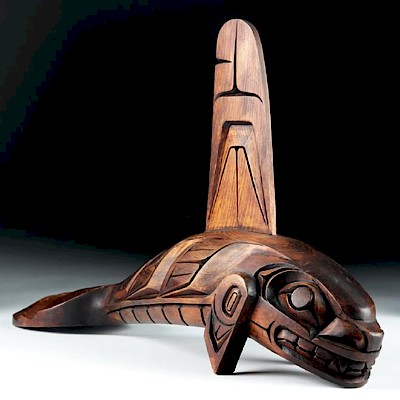Nayarit Pottery Matched Couple, Ex Hollywood
Lot 89
About Seller
Artemis Fine Arts
686 S Taylor Ave, Ste 106
Louisville, CO 80027
United States
Selling antiquities, ancient and ethnographic art online since 1993, Artemis Gallery specializes in Classical Antiquities (Egyptian, Greek, Roman, Near Eastern), Asian, Pre-Columbian, African / Tribal / Oceanographic art. Our extensive inventory includes pottery, stone, metal, wood, glass and textil...Read more
Estimate:
$3,750 - $5,000
Absentee vs Live bid
Two ways to bid:
- Leave a max absentee bid and the platform will bid on your behalf up to your maximum bid during the live auction.
- Bid live during the auction and your bids will be submitted real-time to the auctioneer.
Bid Increments
| Price | Bid Increment |
|---|---|
| $0 | $25 |
| $300 | $50 |
| $1,000 | $100 |
| $2,000 | $250 |
| $5,000 | $500 |
| $10,000 | $1,000 |
| $20,000 | $2,500 |
| $50,000 | $5,000 |
| $100,000 | $10,000 |
| $200,000 | $20,000 |
About Auction
By Artemis Fine Arts
May 24, 2018
Set Reminder
2018-05-24 10:00:00
2018-05-24 10:00:00
America/New_York
Bidsquare
Bidsquare : Northwest Coast, Tribal, & Pre-Columbian Art
https://www.bidsquare.com/auctions/artemis-gallery/northwest-coast-tribal-pre-columbian-art-3238
Featuring Pacific Northwest Coast Native American Art from respected collector / dealer, Joseph Alphabet. Artemis Fine Arts info@artemisfinearts.com
Featuring Pacific Northwest Coast Native American Art from respected collector / dealer, Joseph Alphabet. Artemis Fine Arts info@artemisfinearts.com
- Lot Description
Pre-Columbian, Western Mexico, Nayarit, ca. 300 BCE to 300 CE. A superb set of matched male and female bichrome terracotta figures, each displaying highly-burnished surfaces, vibrant colors, and similar facial expressions. The female has attenuated conical legs and rests upon a pair of tabs protruding from her base. She has a wide torso and prominent breasts, curved arms, and an elegant necklace and pectoral painted in white slip atop a red ground, all while balancing a spouted olla atop her finely-incised coiffure. The male sits atop a single conical protrusion with two attenuated legs and wields a striped club in front of ornate barrel armor. He wears a brimmed, pronged helmet atop his minimalist visage, and a large nose ring hangs in front of a red-and-white-slip face. Circular eyes, pursed mouths, lobed ears, lengthy noses, and slender cheeks define each figure’s expressive countenance, evoking a personalized presentation characteristic of ancient Western Mexico! Size of largest (female): 6.5" W x 11.875" H (16.5 cm x 30.2 cm).
West Mexican shaft tomb figures like these examples derive their names from the central architectural feature that we know of from this culture. These people would build generally rectangular vertical shafts down from the ground level down to narrow horizontal tunnels that led to one or more vaulted or rounded burial chambers. The geomorphology in the area means that these chambers are dug out of "tepetate," a type of volcanic tuff material which give the chambers a rough-edged look. Although the dimensions of the chambers vary considerably - some only large enough to hold a single burial and its offerings, others seem designed to hold entire lineages - the placement of burial goods like this hollow figure was very similar. Grouped with other hollow figures, and alongside clay bowls, and boxes, they were positioned around the body (or bodies), near the skull.
Unfortunately, we lack the information we would need to understand what these figures were made for - Do they represent everyday people, even individuals? Are they religious? Were they created to mediate between the living and the dead? Whatever their purpose, today they are beautiful artwork and reminders of the mysterious past.
For a similar example of the male warrior figure, please see The Museum of Fine Arts, Houston, accession number 86.506: https://www.mfah.org/art/detail/10324?returnUrl=%2Fart%2Fsearch%3Fculture%3DNayarit
Provenance: private Hawaii, USA collection; ex-private T. Misenhimer collection, Hollywood, California, USA, famous Hollywood film producer
All items legal to buy/sell under U.S. Statute covering cultural patrimony Code 2600, CHAPTER 14, and are guaranteed to be as described or your money back.
A Certificate of Authenticity will accompany all winning bids.
We ship worldwide and handle all shipping in-house for your convenience.
#133798Female has repair to olla rim, reattached head and legs, restoration to nose and both posterior tabs, with small nicks to feet, head, olla, and legs. Male has restoration to nose, helmet prongs, large portion of head, lower body, right leg, and club, with repairs to left leg and posterior cone, and small nicks to armor, head, legs, body, and helmet. Both figures have age-commensurate surface wear and abrasions, fading to pigmentation, and minor discoloration. Light earthen deposits throughout.Condition
- Shipping Info
-
All shipping is handled in-house for your convenience. Your invoice from Artemis Gallery will include shipping calculation instructions. If in doubt, please inquire BEFORE bidding for estimated shipping costs for individual items.
-
- Buyer's Premium



 EUR
EUR CAD
CAD AUD
AUD GBP
GBP MXN
MXN HKD
HKD CNY
CNY MYR
MYR SEK
SEK SGD
SGD CHF
CHF THB
THB

















